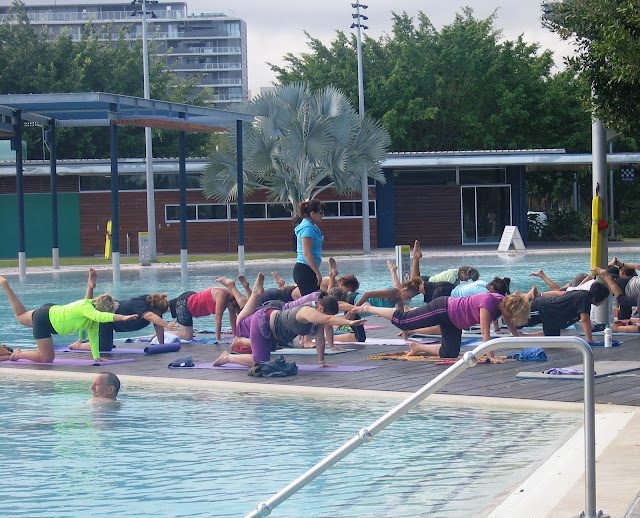When I was a child I:
1. Taught myself to swim at about age 4 by watching other kids having provate swimming lessons and then practicing in another part of the pool. Mum and Dad couldn't afford lessons for me;
2. Had swimming as a school activity, and obtained several life saving awards
3. Would, from about the age of 8, go with other neighbourhood kids, unsupervised, to the the local pool. This was common. The pool was a popular site for local kids, and there was no expectation of parental supervision.
 Above:
Above: Here's where I learned to swim, Malvern City Baths. Used to love that diving board too!
Below: I can picture mum sitting on that grass as I practiced in the pool.

In light of the article below, I wondered just how many drownings take place in public pools. According to
this research, between 1992 and 1997, 3% of drownings in Australia in all age groups were in public or "other" pools (ie not private) pools - 28 individuals in public pools. Of those aged less than 5 years, there were no drownings in public pools (but 170 in private pools, and others in lagoons, buckets, bathtubs)
A study by the
Coroner's Office in Victoria showed that between July 1988 and June 2002, 27 people drowned in Victorian public swimming pools. Of these, three were aged 0-10 and five were aged 11-20. One third ((9) were males aged 21-30. Seven of the 27 deaths were children aged 0-14, two aged under 5.
In 2005, one child aged 0-5 drowned in a public pool and one aged 6-14 drowned in a swimmign pool (whether public or private is unspecified)
Tough new pool safety rules
Rachel Browne
October 12, 2008
LIFEGUARDS are removing unsupervised children from public pools and taking them to safety zones under new guidelines to prevent drownings.
Initiated by the Royal Life Saving Society, the active supervision of children policy has already been implemented in pools managed by the YMCA and some council-run pools.
Under the policy - part of a wider campaign to keep watch at public pools - children aged under five must have a parent or guardian in the water with them and within arm's reach at all times. Children aged between five and 10 must be close enough to a parent or guardian to make eye contact.
YMCA group manager and aquatics program manager Craig Lambeth, who is implementing the policy at YMCA-managed pools, said some parents had reacted badly.
"Under the policy, our staff have to look at the children in the pool, identify those at risk and physically get into the pool, remove them and take them to a safety zone," he said.
"We get absolutely slaughtered by parents for doing it. They will look for their kids, they can't see them and they will go into a panic.
"But we make no apologies for doing it. We are safeguarding their kids. This policy is a guideline only but I'm sure it would be treated as law in a coroner's court."
The YMCA manages 13 pools in NSW, including the Ian Thorpe Aquatic Centre and the Cook + Phillip Park Aquatic and Fitness Centre in Sydney.
Mr Lambeth said parents needed to take more responsibility for their children, rather than assuming lifeguards would supervise them. "They haven't been watching their kid and the kid could have drowned," he said. "We have some kids in the safety zone for half an hour before anyone realises they are missing."
Children can drown in less than a minute and make up a large proportion of annual drowning statistics.
Royal Life Saving Society figures show 35 children aged up to four years old died in 2006-07 and 21 children aged five to 14 died in the same period. They make up nearly a fifth of all drownings in Australia.
Rob Bradley, chief executive of Royal Life Saving and convener of the Australian Water Safety Council, said the "keep watch in public pools" campaign was part of a drive to reduce drownings in Australia by 50 per cent by 2020. He hoped all public pools would implement the policy.
"We just want to remind parents that lifeguards are not baby sitters," he said.
"Parents need to realise that the days of dropping their children off at the pool for a few hours while they go to shops are over. It's not acceptable."
Source: The Sun-Herald



 Above: Here's where I learned to swim, Malvern City Baths. Used to love that diving board too!
Below: I can picture mum sitting on that grass as I practiced in the pool.
Above: Here's where I learned to swim, Malvern City Baths. Used to love that diving board too!
Below: I can picture mum sitting on that grass as I practiced in the pool.
 In light of the article below, I wondered just how many drownings take place in public pools. According to this research, between 1992 and 1997, 3% of drownings in Australia in all age groups were in public or "other" pools (ie not private) pools - 28 individuals in public pools. Of those aged less than 5 years, there were no drownings in public pools (but 170 in private pools, and others in lagoons, buckets, bathtubs)
A study by the Coroner's Office in Victoria showed that between July 1988 and June 2002, 27 people drowned in Victorian public swimming pools. Of these, three were aged 0-10 and five were aged 11-20. One third ((9) were males aged 21-30. Seven of the 27 deaths were children aged 0-14, two aged under 5.
In 2005, one child aged 0-5 drowned in a public pool and one aged 6-14 drowned in a swimmign pool (whether public or private is unspecified)
In light of the article below, I wondered just how many drownings take place in public pools. According to this research, between 1992 and 1997, 3% of drownings in Australia in all age groups were in public or "other" pools (ie not private) pools - 28 individuals in public pools. Of those aged less than 5 years, there were no drownings in public pools (but 170 in private pools, and others in lagoons, buckets, bathtubs)
A study by the Coroner's Office in Victoria showed that between July 1988 and June 2002, 27 people drowned in Victorian public swimming pools. Of these, three were aged 0-10 and five were aged 11-20. One third ((9) were males aged 21-30. Seven of the 27 deaths were children aged 0-14, two aged under 5.
In 2005, one child aged 0-5 drowned in a public pool and one aged 6-14 drowned in a swimmign pool (whether public or private is unspecified)  Below: Looking north across the mudflats
Below: Looking north across the mudflats Below: Grassy areas with shady trees and barbecues
Below: Grassy areas with shady trees and barbecues Below: The beach
Below: The beach Below: I love these "woven" steel fish sculptures which spout water. They are by Brian Robinson. Woven Fish was commissioned by the Cairns City Council and the Queensland Government and completed in 2003.
Below: I love these "woven" steel fish sculptures which spout water. They are by Brian Robinson. Woven Fish was commissioned by the Cairns City Council and the Queensland Government and completed in 2003.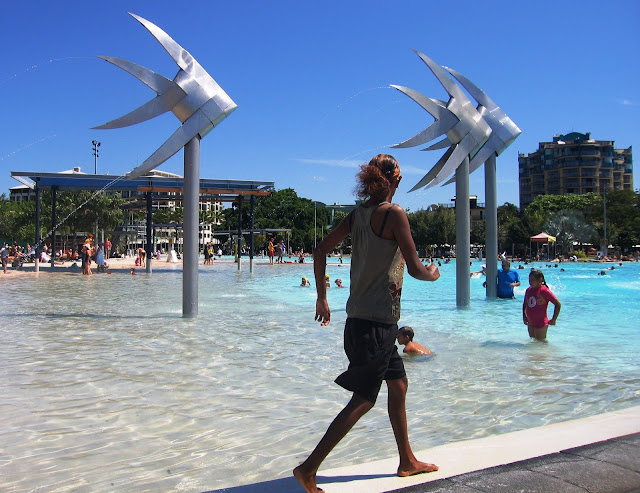

 Below: Aerial view of central Cairns, with the esplanade lagoon clearly visible
Below: Aerial view of central Cairns, with the esplanade lagoon clearly visible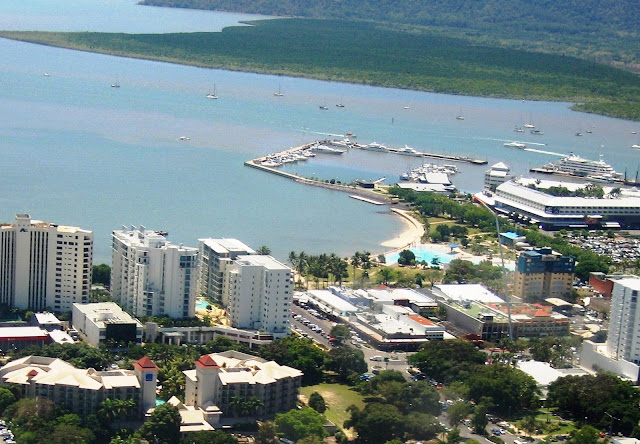
 Below: Hmmmm....I wonder what will happen if I put this...here.
Below: Hmmmm....I wonder what will happen if I put this...here. Below: A delicate touch
Below: A delicate touch
 Below: Still swimming after dark
Below: Still swimming after dark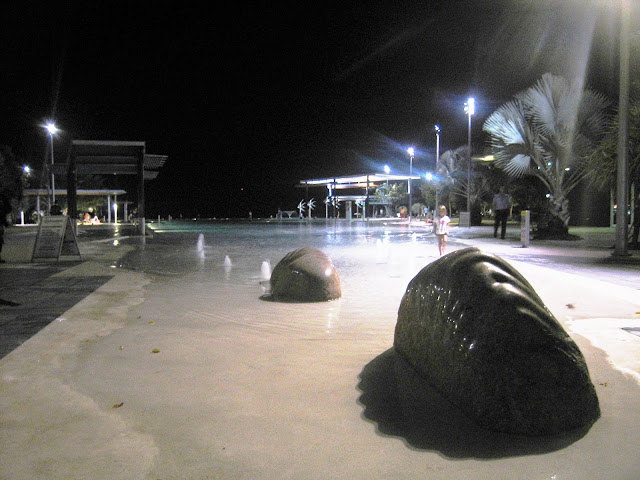
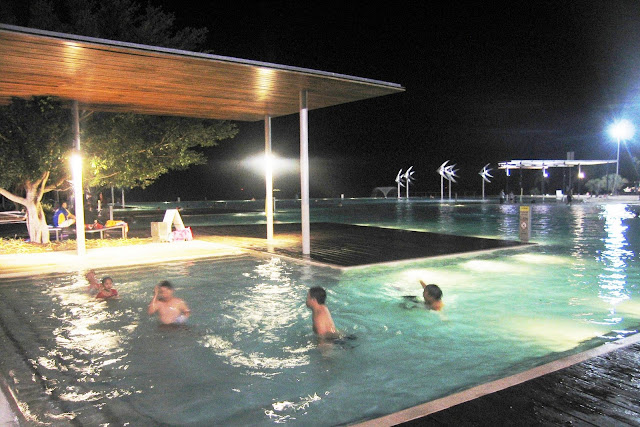 Below: Early morning Pilates class
Below: Early morning Pilates class